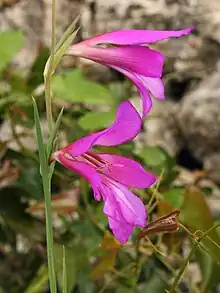| Gladiolus illyricus | |
|---|---|
 | |
| Gladiolus illyricus in the Algarve region | |
| Scientific classification | |
| Kingdom: | Plantae |
| Clade: | Tracheophytes |
| Clade: | Angiosperms |
| Clade: | Monocots |
| Order: | Asparagales |
| Family: | Iridaceae |
| Genus: | Gladiolus |
| Species: | G. illyricus |
| Binomial name | |
| Gladiolus illyricus W.D.J.Koch | |
Gladiolus illyricus, the wild gladiolus, is a tall gladiolus plant that grows up to 50 centimeters (20 in) tall found in western and southern Europe, particularly around the Mediterranean region.
In Britain a small population is known in the New Forest region; Williamson suggests this population may be introduced.[1][2] It became a protected species in the UK in 1975 under the Conservation of Wild Creatures and Wild Plants Act.[3]
References
- ↑ David Pimentel, Ph.D. (31 October 2014). Biological Invasions: Economic and Environmental Costs of Alien Plant, Animal, and Microbe Species. CRC Press. p. 93. ISBN 978-1-4200-4166-8.
- ↑ Norman Maclean (16 April 2015). A Less Green and Pleasant Land: Our Threatened Wildlife. Cambridge University Press. p. 129. ISBN 978-1-316-06227-2.
- ↑ "Caithness CWS - Caithness Field Club - Annual Bulletins - 1975 - October - Conservation".
External links
This article is issued from Wikipedia. The text is licensed under Creative Commons - Attribution - Sharealike. Additional terms may apply for the media files.